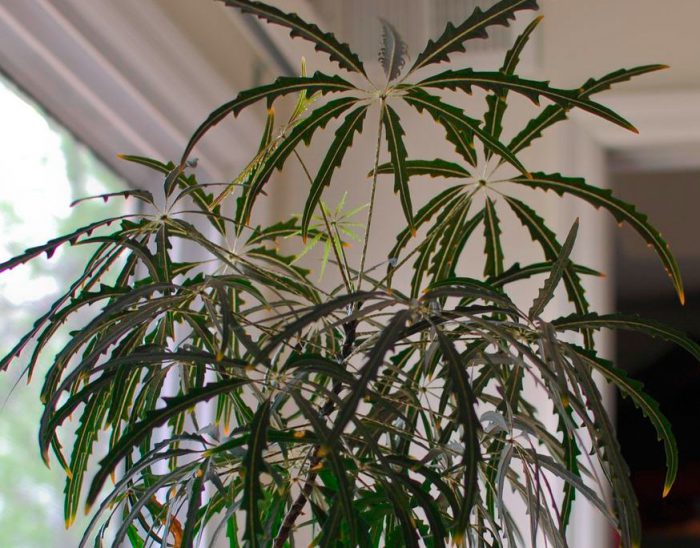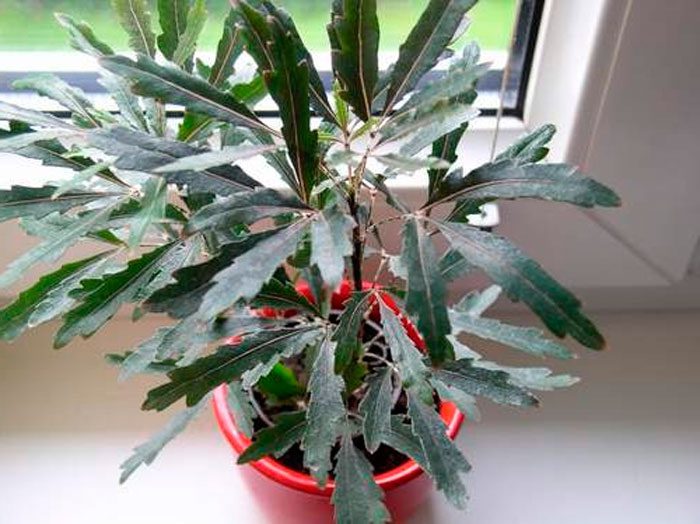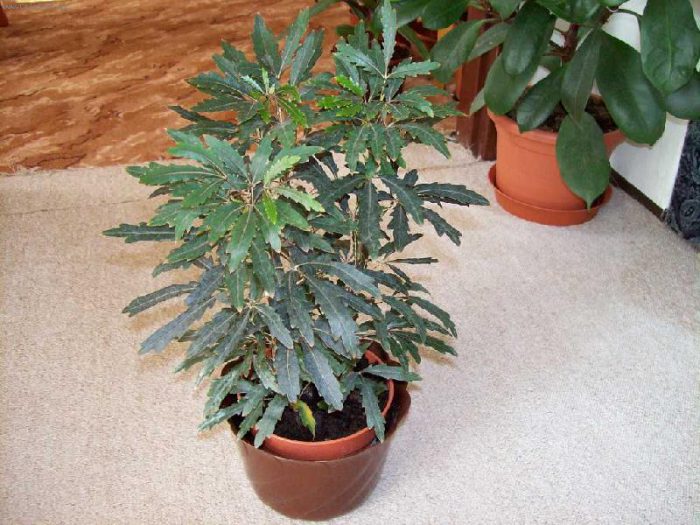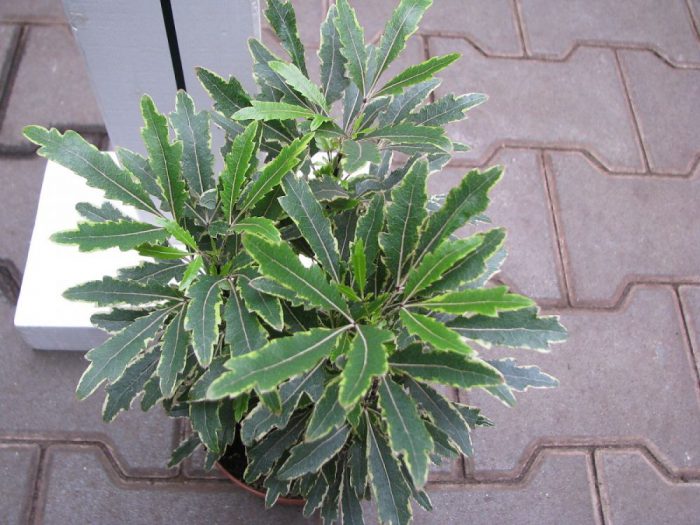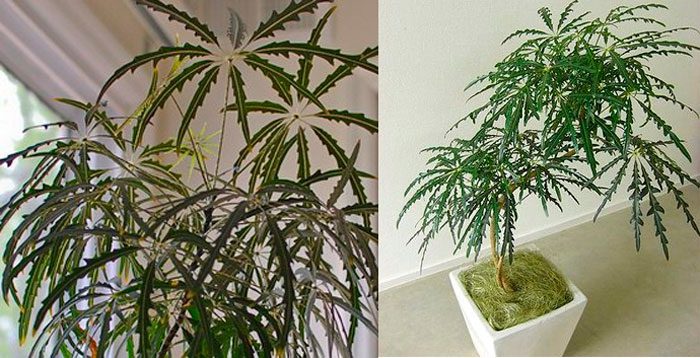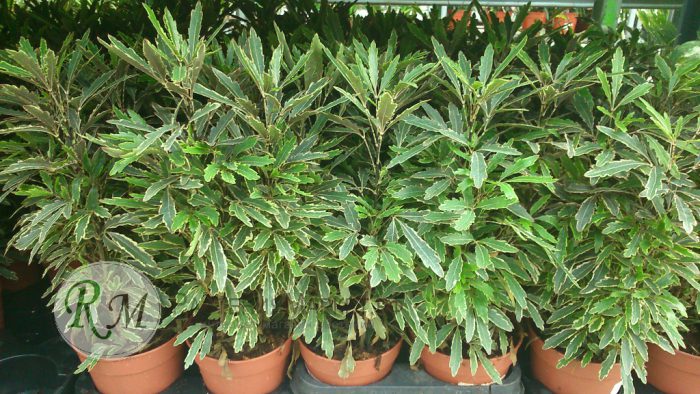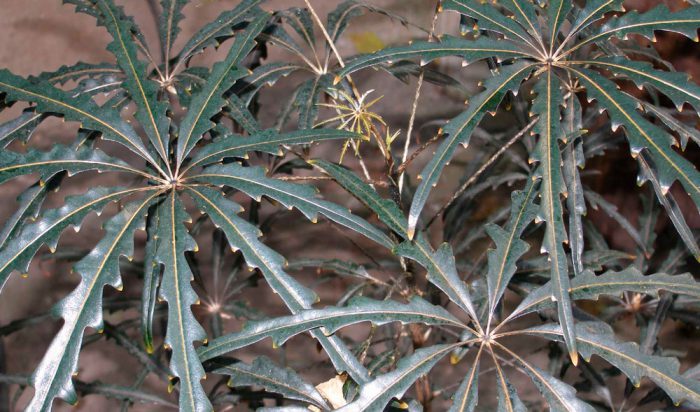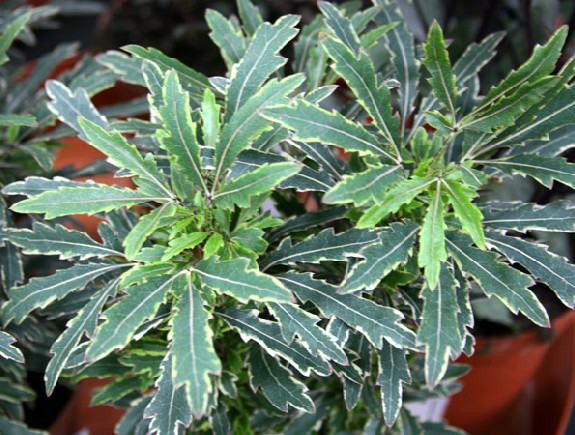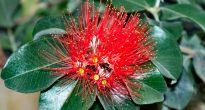Dizigoteka Is a beautiful decorative leafy houseplant native to Australia and Oceania. It is rare in modern homes. For some, she does not look so attractive, for others it seems that she is too demanding and capricious. Many have never seen her, and do not know anything about her. Nevertheless, it is a wonderful indoor flower that can decorate a windowsill in an apartment or office.
Dizygoteka is an elegant evergreen shrub with serrate leaves, serrated at the edges. In most cases, they are black-brown in color. Certain species have copper-colored leaves.
Content
Dizygoteka care at home
Transfer
It is better to buy a dizygotek when the weather is clear and sunny. The plant does not tolerate sudden temperature changes and drafts. Usually there are three plants in one pot. Since the dizigoteca in the store is located in peat crumb, after purchase it must be transplanted immediately. It is better to purchase soil for the plant in a specialized flower shop. This type of potting mix is suitable for alocasia and dracaena. The soil should be nutritious, good for air and moisture. To avoid the appearance of root rot, a baking powder (expanded clay, vermiculite or charcoal) is added to the soil.
Home dizygotek is transplanted every two to three years. Transshipment is carried out in the spring, only to a new land. Young specimens need a larger pot; adult plants are left in the same container. When the roots are cramped, the plant develops better. When transplanting a dizygotek, care is taken not to damage the roots. Having previously watered with warm water, the old soil is carefully crushed from the flower and placed in a new one. After transplanting, it is also watered with warm water. Adult plants do not overload. They just refresh the top layer.
To make the plant look more attractive, 2-3 small plants are planted in one pot. A pot with a large tree should be heavier as it can tip over.
Watering
Dizygoteka needs moderate regular watering. Excessive moisture can harm the plant. The soil in the pot will begin to acidify, the roots will rot and the flower will die. The plant is watered when the top layer of the earth dries up. Water for irrigation should be soft. Rainwater or well-settled water at room temperature will do. In summer, the amount of watering is increased, in winter, it is reduced. Discarded leaves indicate insufficient watering.
Top dressing, fertilization
Fertilizers are applied twice a month, during the period of intensive growth. You can also prepare a special spray solution by diluting the fertilizer in half with water. The plant is very fond of a warm shower. If you take care of it properly, it will grow rapidly and delight you with its beauty.
Temperature
Dizigoteca is a thermophilic tree that adapts perfectly to room temperature. When 18-28 ° C the plant will feel great. In winter, the indoor temperature should not fall below 18 degrees, otherwise the plant will shed its leaves. With dry air and high temperatures in the house, the tips of the leaves of the plant will dry out. It should be borne in mind that the tree does not tolerate temperature extremes.
Humidity
Dizygoteka must be kept in a special climate with high humidity. To make the tree feel comfortable, the crown is regularly sprayed with warm water. A pallet with wet pebbles or expanded clay is placed next to the pot. To maintain constant moisture, the soil is covered with moss on top.
Lighting
The tree prefers bright diffused light. The light source must be constant. Otherwise, leaves may fall off. Oriental windows are suitable for the plant. On the north side, it will lack light, in the south and west it will need shading. Daylight hours should last 10-12 hours, therefore phytolamps are used in winter and rainy days. Dizygoteka adapts well to artificial light.
In the summer, the plant cannot be taken outside, it will not adapt, since it is intended for indoor cultivation. The scorching sun, heat and dry air will destroy the tree.
Pruning
Dizygoteka refers to small-branched trees. As it matures, it loses the lower leaves and stretches upward. Without pruning, it will look like a palm tree. Pruning deep will help the plant stagnate and regenerate.
Pruning is carried out annually in early spring. If the mature plant is shortened, new shoots will begin to grow from the base of the trunk.
Reproduction
There are two ways to breed a dizigoteca. This procedure is carried out in the spring. Most often, the plant is propagated by seeds. For them, a special substrate is prepared, consisting of a mixture of sand and peat. After sowing, the seedlings are covered with foil.
In some cases, apical cuttings are used to obtain a new plant. Without the use of phytohormones, they cannot be rooted. When planted in the ground, greenhouse conditions are created by heating the lower part of the container with the substrate. Rooting in boiled water with activated carbon is possible. In this case, the appearance of roots should be expected in 3-4 months.
Pests
Dizygoteka is extremely rarely attacked by pests. The danger for her is the scabbards and thrips.
With proper care, the dizygoteka looks very beautiful, it grows 30-50 cm annually. An adult tree grows slowly. It will be able to decorate the living room, hall in an official institution. When kept in heat and moisture, there will be no problems with it.
Types of dizigothek with photos and names
The genus Dizigoteka has about 17 plant species. Of these, only 3-4 species are grown in indoor floriculture.
Dizigoteka elegant
Refers to tree-like weakly branching evergreens. It has compound, palmate leaves located on long petioles. The number of dark green leaves ranges from 4 to 11. They have a linear shape, jagged edges. Nondescript small flowers are collected in umbellate inflorescences. Breeders have developed new varieties of this species. They have different colors and sizes of leaves.
Dizigotek Veitch
Outwardly, it is very similar to Dizygotek elegant, but its leaves are wide, with wavy edges.

